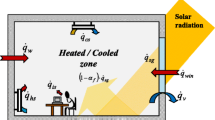Abstract
A numerical model is developed to assess the static and dynamic operations of a new kind of floor heat emitter. Surface floor heating systems are widely used to achieve better comfort conditions in residential and tertiary building sector. Classical floor heating systems have a low thermal response while the emitting device studied in this paper is highly reactive. It allows comfort enhancement and energy savings. A finite element method based software COMSOL Multiphysics is applied to solve the heat equation. This work focuses on the thermal behaviour of the emitter itself, but does not include a building model. A test bench has been built for this application to verify the numerical model. Both computational and experimental results demonstrate the benefits of this new heating and cooling device.
Similar content being viewed by others
References
CEN (2005). 15377-1 (draft) — Heating systems in buildings — Design of embedded water based surface heating and cooling systems — Part 1: Determination of the design heating and cooling capacity. European Committee for Standardization, CEN, Europe.
COMSOL (2010). COMSOL Multiphysics 4.0a Multiphysics Modeling and Engineering Simulation Software. Licensed to University of Liège, COMSOL AB, Stockholm, Sweden.
EPCOS (2009). NTC thermistors for temperature measurement. Series B57703M. Available online at: http://www.epcos.com/inf/50/db/ntc_09/ProbeAss_B57703_M703.pdf. Accessed 20 Dec. 2010.
Fonseca Diaz N, Lebrun J, André P (2010). Experimental study and modeling of cooling ceiling systems using steady-state analysis. International Journal of Refrigeration, 33: 793–805.
Franck P-Y (2010). How does the OPAL-Systems solution function? Available online at: http://www.opal-systems.be/concept-40000-4.html. Accessed 23 Nov. 2010.
Karlsson H (2010). Embedded Water-based Surface Heating Part 1: Hybrid 3D numerical Model. Journal of Building Physics, 33: 357–391.
Liébard A, De Herde A (2006). Traité d’architecture et d’urbanisme bioclimatiques. Editions du Moniteur. (in French)
Measurement Specialities (2008). 10K3A1 Series 1 Thermistor. Available online at: http://www.meas-spec.com/assets/0/78/128/438/d8567bef-ab6b-40dc-9454-77924ea543b6.pdf. Accessed 20 Dec. 2010.
Rohsenow WM, Hartnett JP (1973). Handbook of Heat Transfer. New York: McGraw-Hill.
Thomas S, Franck P-Y, André P (2009). Optimization of dynamic embedded, water based surface heat (and cold) emitting system for buildings. Paper presented at the COMSOL Conference 2009, Milan, Italy.
Thür A (2010). Monitoring program of small-scale solar heating and cooling systems within IEA-SHC Task 38 — Procedure and first results. In: Proceedings of the ISES IEA-SHC Eurosun 2010 Conference, Graz, Austria.
TRNSYS (2010). TRNSYS simulation studio, Version 17.00.0016. Licensed to University of Liège, Solar Energy Laboratory, Madison, USA.
Author information
Authors and Affiliations
Corresponding author
Rights and permissions
About this article
Cite this article
Thomas, S., Franck, PY. & André, P. Model validation of a dynamic embedded water base surface heat emitting system for buildings. Build. Simul. 4, 41–48 (2011). https://doi.org/10.1007/s12273-011-0025-8
Received:
Revised:
Accepted:
Published:
Issue Date:
DOI: https://doi.org/10.1007/s12273-011-0025-8




